
For a column called Hell Notes, it seems odd that it’s taken me almost two years to get to Hell itself. I guess I shall rectify that oversight now…
In yesterday’s issue of B.P.R.D. Hell on Earth we got another look at how things are going in Hell. And I mean, I know it’s Hell, but it’s seen better days. So this month I’m going to be looking at Hell… and there’s going to be a lot of speculation this time. Way more questions that answers, that’s for sure.
Spoiler Warning. You’d better be up to date, because I’m spoiling everything. Well, everything to do with Hell anyway.
Rather curiously, Hell did not make an appearance in “Hellboy” until 1999. The series was already five years old by then, and even when it did appear it was in Pancakes, a two-page piece, with the scenes in Hell played purely for comedy.
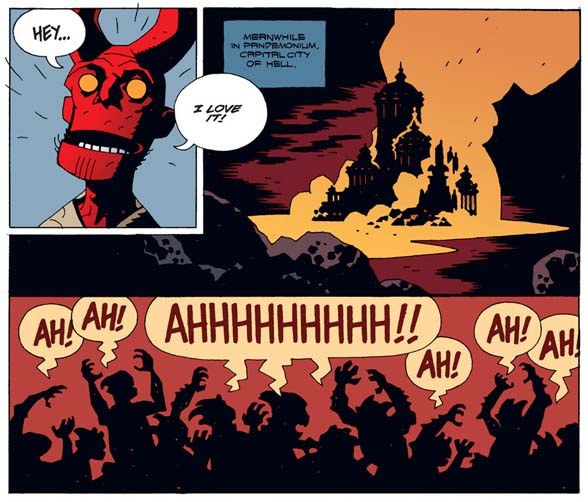
Over time Hell has played a larger and larger role in the Hellboy Universe, especially now that it’s where Hellboy is spending all his time since his death. But what is Hell in the Hellboy Universe? After all, there are many variations of Hell depending on which mythology or religion you look at.
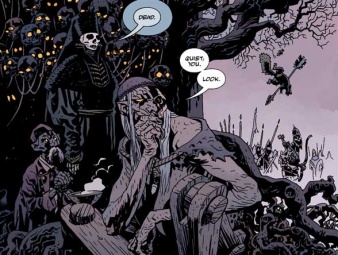
Now, I don’t know how Yggdrasil fits into Mike Mignola’s cosmology, but in Norse mythology this ancient ash tree connects the nine planes of existence, including Midgard, which I guess would be the equivalent of Earth and rest of the universe. Apparently the other eight planes intersect with the Midgard plane at certain points, but are otherwise almost completely invisible and inaccessible to mortals. I guess that roughly approximates what’s going on in the Hellboy universe too. In Norse mythology, with only a few exceptions, mortals had no way to access other realms, and those that did access them were changed by them so that they were no longer the mortals they once were. That’s kind of like Hellboy’s girlfriend, Alice Monaghan, whose contact with the fairies allowed her to drift into the fairy realm while she slept, and later even when she was awake. She was changed by this, becoming much more intuitive about the unseen world around her, and was much older than her appearance would suggest. She’s no longer just your average human, that’s for sure. In fact, she may even have become something else, but that’s something I’ll have to explore in another Hell Notes.


Time in Hell isn’t just faster or slower. It’s pretzeled. Or maybe Earth’s time is pretzeled. Or maybe different regions of Hell sync up with different periods of Earth’s timeline. Either way, it’s all relative. Events on Earth and in Hell certainly affect each other, but in a non-linear manner. And while that may be confusing for you or myself, for the residents of Hell this seems to be nothing special. It’s just the way things are, and it seems pretty straightforward to them.
OK, so I guess now that we’ve located Hell in time and space (sort of), I guess I should probably explain what Hell is, and who its residents are. This is going to require a quick lesson in ancient prehistory.
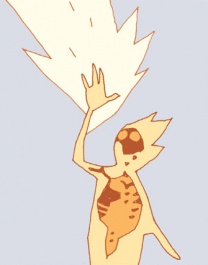
Then the wrath of God came upon them in retribution for what they done. Some were cast down onto the Earth to breed monsters, while others when cast into the Pit (essentially another name for Hell as far as I know). This was the First Fall of Angels. What happened to most of those spirits cast into Hell, I cannot say. But more would follow.

This is the lineage of Hell’s aristocracy. They come from the Second Fall. Perhaps some even come from First Fall, those that have been there longest. So when I say that Hellboy’s father, Azzael, was a Prince in Hell, whose seat of power was in the Citadel of the Fly, the beating heart of Pandemonium, I hope you will appreciate the magnitude of that. Azzael was one of the most powerful demons in Hell, and if he wasn’t one of the Greater Spirits that had been cast down into Hell with Lucifer, then he was certainly descended from them.
OK, so now let’s talk geography, starting with where Hellboy first arrived: the Abyss. Sir Edward Grey described the Abyss to Hellboy as being “not quite Hell.” It is the outer edge, the bottomless depths of chaos. Could this be the same Abyss where the prison of the Ogdru Jahad was cast? I’m not so sure. In that context “the Abyss” could also mean the far reaches of space. Or maybe the Abyss between the fabric of all other planes where the Ogdru Hem spirits drift after they were torn from their bodies… Yeah, actually “the Abyss” is a term that may be used to refer to at least three distinct “places.” But in regards to Hell specifically, “the Abyss” means what Sir Edward said: bottomless depths of chaos. And its full of insect and crustacean-like creatures and tentacles.
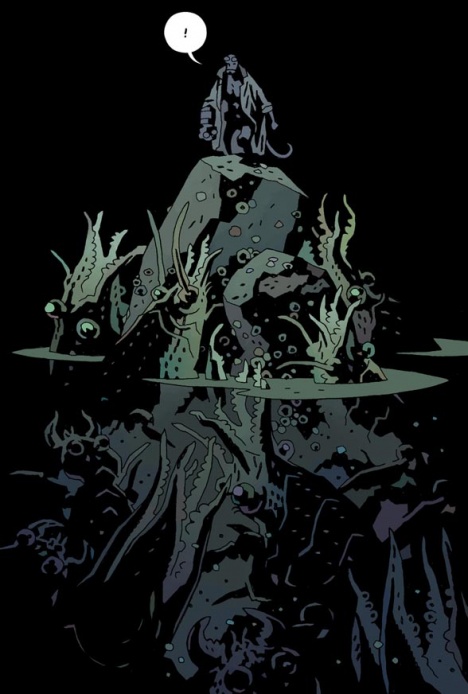
As for Hell itself, thanks to Hellboy in Hell: The Death Card, we’ve got access to a rudimentary grasp of its geography. In a pub Hellboy met two men, Mister Jenks and Mister Dean, who wear attempting to create a map of Hell.3 According to this pair, Hell is best visualised as a great bowl with water at the bottom. That water is the Stygian Sea, and at its centre, the Lake of Fire.
Continued below
At the centre of the Lake of Fire, Pandemonium, the Capital of Hell. All around the Stygian Sea are the Cities of Hell, although they’re rather more like a single city, a maze-like tangle of buildings and streets. The Cities of Hell are divided into regions, so one could wander into a Prague-like Hell, or a Japanese Hell, or an Indian Hell, or any other civilisation of humanity. Beyond the cities are impassable forests, unclimbable mountains, and beyond those, a frozen wasteland reaching all the way to the bowl’s rim, beyond which lies the Abyss.
That description makes it sound a little small perhaps, but the princes, ministers, dukes, marquis, earls, and knights of Hell do not all dwell in Pandemonium. They have entire countries in Hell, their own lands to rule. Hell is a place likely as vast as Earth itself, or perhaps even more so.
There are also the rivers of Hell, the same ones that encircle Hades in Greek mythology, Cocytus (meaning “lamentation,” the river of wailing), Acheron (the river of pain and woe), Lethe (meaning “oblivion,” the river of forgetfulness or unmindfulness), Styx (the river of hatred), and Phlegethon (the river of fire). In Greek mythology Phlegethon’s waters ran into the depths of Tartarus, a place as far beneath Hades as the Earth is below the heavens (or as far as an anvil would travel if falling for nine days). Tartarus was the prison of the Titans. Though Tartarus and Phlegethon have not been mentioned in any of Mignola’s stories, the word Titan has been used to refer to the Watchers on occasion. Perhaps it is possible those Watchers cast down into Hell during the First Fall were cast into its greatest depths, into Tartarus.

Later, on the banks of Cocytus, Hellboy saw the Fisher of Souls. His name long forgotten, his eyes burned out by spark and his ears shattered by the sound of his own hammer, he is both blind and deaf. This nameless giant was one of the Watchers that tore Anum apart. It was he, with his mighty hammer, that built Pandemonium, and since the coming of Man he has been at work. The waters of Cocytus flow from Earth to Hell, and they carry the Common Damned. Not great monsters, but misspent lives. These souls swim in the Cocytus in the form of fish until they are taken up by the Fisher of Souls and beaten by his hammer upon his anvil. Each soul is made into a warrior, a part of the Great Army of Hell, the only power there is able to break down the walls that separate Hell from Heaven and Earth. It is a dead army, which can only be brought to life by the power of Hellboy’s Right Hand of Doom.

Finally there’s the river Acheron. When the witchfinder Sir Edward Grey was dragged into Hell in 1916 by the demon Amdusias, he was cursed to live forever, then torn to pieces and cast along the banks of Acheron. At that time there were creatures (now gone) that lived in the rocks there. They gathered up the pieces of Sir Edward and stitched him together as best they could, and eventually they brought him to a house, the home of the Warlock Angus Weir.
Weir had sold his sold, but attempted to cheat his way out of his payment. His masters in Hell sent a horde of demons to snatch up his house from the coast of Scotland and bring it to the edge of Acheron. But Weir had inscribed the house with symbols that barred any demon or creature of Hell from entering. So he lived alone in his house, and with his dying breath he renounced all his evil works and begged forgiveness.
It was here, in the home of Angus Weir, that Sir Edward made his home. Interestingly, the symbols that barred demons from entering have no effect on Hellboy, proof that he is something other than just a creature of Hell.
Continued below
Hellboy’s journey also took Hellboy to his father’s home. Here Hellboy met his Uncle and fought with his elder brothers, a fight that took them outside to a frozen landscape, and afterward Hellboy floated away on a chunk of ice into the Abyss. So it seems his family home is on the very rim of the bowl of Hell.
And that’s about it for geography… which brings us to the most interesting part of Hell: the politics. As you know, Hell’s where all the damned end up; the Greater Spirits, the humans, most likely the Hyperboreans, and possibly even the final Race of Man too. It’s important to remember that while Satan is the King of Hell, even he is damned.

Throughout the Hellboy Universe there have been many tales involving “the Devil,” and I can tell you right now, virtually all of them aren’t about the Devil. It seems as soon as a human meets a demon, they immediately jump to the conclusion that it must be the Devil, and the demon perpetuates this misconception because, hey, these stupid humans think they’re the Devil. They are devils, but they aren’t the Devil with a capital D.
So what’s the real Devil, Satan, been doing? Well, for almost two thousand years, he’s been sleeping. Why’s he sleeping? No idea. It’s not really addressed in the books, however “almost two thousand years” does fit with a certain event from the Christian Bible, the death and resurrection of Jesus at approximately 33 CE. While it has already been established on numerous occasions that the Christian Bible does not square with Mignola’s true history of the world, aspects of it certainly have some truth in it. As Ota Benga said in B.P.R.D.: 1947, “Man has given a thousand different names to his god, but look into the face of each one―long enough―hard enough―you will find one truth.” So there are pieces in many, possibly all, religions that have truth in them (though perhaps not fact). My point being that perhaps in the Hellboy Universe there was a Jesus (or Jesus-like figure on which the Jesus myth is based) almost two thousand years ago, and at that time this person dealt a blow to Satan that made him retreat to his chamber for a couple of millennia. Unless of course Satan has been sleeping for almost two thousand years Hell time, in which case when he went to sleep it could have been a very different point in Earth’s history. Perhaps it was right after Hellboy ate his first pancake.
Either way, the boss sleeping all the time left a power vacuum in Hell, one that the aristocracy of Hell clamoured to fill, including Hellboy’s father, Azzael, and Hellboy’s Uncle, Astaroth.


What’s really strange though is that he gave the Right Hand of Doom to Hellboy. Why were Hellboy’s older brothers, Gamon and Lusk, overlooked? Why was his sister, Gamori, not considered? Azzael called Hellboy his favourite son even before he was born. But why was he his favourite? Not even Hellboy’s uncle, Astaroth, knew. Yet still, he was there to witness Hellboy’s birth. It seems that Azzael had let his brother in on some of his plan, though certainly not all of it. And he never told him how he came by the Right Hand of Doom.
In the past many have tried to take Hellboy’s Right Hand, but never any of the truly powerful demons of Hell. Astaroth, for example, never wanted the Right Hand of Doom for himself, he simply wanted to control the one that wielded it. The fate of the Hand’s bearer is not something he wants for himself. Astaroth’s frustration with Hellboy had always been because Hellboy would never listened to him no matter what he tried. When he finally gave up, he tried to have Gamon and Lusk claim it. That plan didn’t exactly pan out though, and ended up with Astaroth, Gamon, and Lusk all dead… or at least in the belly of Leviathan.

According to Sir Edward Grey, with Astaroth gone, there’s no one left in Hell that wants the Hand, or at least no one left with the ambition to take it. So what happened to all those princes, ministers, dukes, marquis, earls, and knights of Hell? Well, at the news of Hellboy’s coming to Hell, they fled the capital. After all, it had been prophesied that Hellboy would come to Pandemonium and kill Satan in his sleeping chamber, then he would go up into the city and throw down all the princes and generals. Then he would claim the Crown of the Apocalypse waiting for him on his father’s throne, take up his father’s sword, and breathe life into the Great Army of Hell. Then he would break down walls of Hell, and riding a black dragon, he would lead that army to Earth.

Hellboy has yet to take up the Crown of the Apocalypse or his father’s sword, but it seems that he will. As I said before, time on Earth does not exactly line up with time in Hell, and in Hellboy: Darkness Calls, when Igor Bromhead lay dying, he spoke of being in Hell, where he could see Hellboy seated on a dragon at the head of an army. This moment has yet to happen for Hellboy, but if previous stories set any kind of precedent, it will happen, just not in the way we would assume.
Continued below
And then there’s the matter of Satan’s death. Just as had been foretold, Hellboy stole into Satan’s bed chamber and murdered him. But the weird thing is, Hellboy doesn’t remember it, or at least he didn’t at first, and then he started remembering bits and pieces, but there are still pieces missing. The thing is, Hellboy had no motivation for doing this. He’d been told it was his destiny and Hellboy being Hellboy, he hates the destiny box and tries to bust out of it every time someone tries to put him in it. So when presented with the opportunity to kill Satan, he’d turn it down on principle.

So then… why did he kill Satan?

I know Sir Edward Grey has said there’s no one left in Hell with the ambition to take the Right Hand of Doom, but Sir Edward is not all-knowing. He is fallible. Gamori may not try to take the Hand, but as we saw in Hellboy: The Midnight Circus, she is better at reading and manipulating Hellboy than Astaroth ever was. Without actually taking the Hand, she could still potentially make use of it through Hellboy.
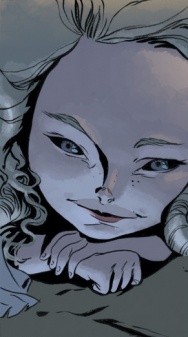
While the aristocracy of Hell forfeited their right to rule and fled at Hellboy’s coming, Varvara did no such thing. She was sealed away in Moscow, powerless in her prison, yet the bonds of power she had over the enslaved demons of Hell is unchanged. Unlike her dead fellows, when she commands, the enslaved demons must obey, as shown in B.P.R.D. Hell on Earth: A Cold Day in Hell when Varvara’s exploited a temporary weakness in her prison. Varvara may now be the single most dangerous demon alive.

And that’s the current state of politics in Hell. Which brings me to one last topic… death. Specifically what is death in Hell?
Astaroth, Gamon, and Lusk were all eaten by Leviathan. They’re gone, but are they dead? I ask this because this is Hell. It’s not like the damned can kill themselves and it’s over. They suffer for eternity. And as we’ve already established, even Watchers are damned here, and they are very powerful beings. So are Astaroth, Gamon, and Lusk all still alive in the belly of Leviathan, a shell of their former selves, unable to escape, being digested for the rest of eternity as Leviathan swims in the waters of the Abyss?
So what about Satan? What about the aristocracy of Hell that were torn apart and eaten by their minions? I assume these guys at least are dead. So what are the rules of death in Hell? I don’t know, and I’m genuinely curious. My current interpretation (which may be hideously, horribly, and horrendously wrong) is that death in Hell is to be torn from all ties of power, to become nothing but a tortured witness for the rest of eternity. Perhaps Satan now walks the halls of Pandemonium as a powerless ghost.
In The Death Card the nature of death, at least for the mortal humans condemned there, was explored. Over time those darkest of souls are drawn out from their ghost in Hell and then cast into the Lake of Fire to burn for eternity. But this is not the fate of all. There is still forgiveness even in Hell, and a soul can be released from its prison. Even in Hell there is hope.
Continued below
Then there are others like Hellboy and Sir Edward Grey that were not condemned to Hell, but rather dragged down into it. I don’t believe Sir Edward Grey was ever tethered to Hell when he was first brought there, and once he found a way out, he was free to go, but at the beginning of Hellboy in Hell #1 when he tied his fate to Hellboy’s, there was no going back. He was told as much by the Baba Yaga and the ghost of Angus Weir.
So what tethers Hellboy to Hell? I believe it’s his heart. Nimue, the Queen of Blood, ripped out Hellboy’s heart and dragged it down into Hell. And I think that if Hellboy can find his heart, then he will be free to leave Hell as long as he can find an exit.

So that’s my crazy theory. Do you have any of your own you’d like to share?
Speaking of Hellboy looking more dead than usual, have you seen the cover for Hellboy in Hell #7: The Hounds of Pluto (Part 1) yet? This issue will be coming out on the 26th of August, followed by Part 2 in September.

FOOTNOTES
1Shambhala: This was mentioned in Witchfinder: In the Service of Angels, a Hyperborean city, a paradise, built in the Hollow Earth. In reality there was no paradise, but the city of Shambhala may still be real. If we’re ever going to find out, I’d wager it would be in the pages of Frankenstein Underground.

2Time: It’s not just Hell that has a twisted temporal relationship with Earth, but likely essentially all planes of existence. In the Baba Yaga’s forgotten Russia, beyond the Thrice-Nine Lands in the Thrice-Tenth Kingdom, the Baba Yaga waited ten thousand years to get revenge on Hellboy for taking her eye (Hellboy: Darkness Calls). By Earth’s timeline though these events were much closer together, separated by a little over forty years. So when the Second Spirit in Hellboy in Hell #2 said “ten million years,” it’s impossible to tell how long ago these events really were.
3Mister Jenks and Mister Dean: This encounter in the bar in Hell is not the first time these men have appeared. In Witchfinder: In the Service of Angels, 1879, they were in an English pub chatting about the possibility of a Hollow Earth.







